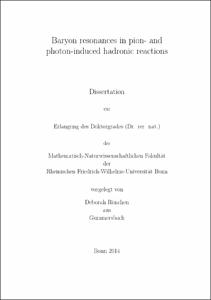Rönchen, Deborah: Baryon resonances in pion- and photon-induced hadronic reactions. - Bonn, 2014. - Dissertation, Rheinische Friedrich-Wilhelms-Universität Bonn.
Online-Ausgabe in bonndoc: https://nbn-resolving.org/urn:nbn:de:hbz:5n-35717
Online-Ausgabe in bonndoc: https://nbn-resolving.org/urn:nbn:de:hbz:5n-35717
@phdthesis{handle:20.500.11811/6076,
urn: https://nbn-resolving.org/urn:nbn:de:hbz:5n-35717,
author = {{Deborah Rönchen}},
title = {Baryon resonances in pion- and photon-induced hadronic reactions},
school = {Rheinische Friedrich-Wilhelms-Universität Bonn},
year = 2014,
month = apr,
note = {The aim of the present work is the analysis of the baryon spectrum in the medium-energy regime. At those energies, a perturbative treatment of Quantum Chromodynamics, that is feasible in the high-energy regime, is not possible. Chiral perturbation theory, the low-energy effective theory of the strong interaction, is limited to the lowest excited states and does not allow to analyze the complete resonance region. For the latter purpose, dynamical coupled-channel approaches provide an especially suited framework. In the present study, we apply the Jülich model, a dynamical coupled-channel model developed over the years, to analyze pion- and photon-induced hadronic reactions in a combined approach.
In the Jülich model, the interaction of the mesons and baryons is built oft- and u-channel exchange diagrams based on an effective Lagrangian. Genuine resonances are included as s-channel states. The scattering potential is unitarized in a Lippmann-Schwinger-type equation. Analyticity is preserved, which is a prerequisite for a reliable extraction of resonance parameters in terms of pole positions and residues in the complex energy plane. Upon giving an introduction to the subject in Chap. 1 and showing selected results in Chap. 2, we will describe the simultaneous analysis of elastic πN scattering and the reactions π-p → ηn, K0Λ, K+Σ-, K0Σ0 and π+p → K+Σ+ within the Jülich framework in Chap. 3. The free parameters of the model are adjusted to the GWU/SAID analysis of elastic πN scattering and, in case of the inelastic reactions, to experimental data. Partial waves up to J=9/2 are included and we consider the world data set from threshold up to E~2.3 GeV. We show our fit results compared to differential and total cross sections, to polarizations and to measurements of the spin-rotation parameter. Finally, we present the results of a pole search in the complex energy plane of the scattering amplitude and discuss the extracted resonance spectrum in the isospin I=1/2 and I=3/2 sector.
The approach will be extended to pion photoproduction in Chap. 4. Here, the reactions γp → π0p and γp → π+n are analyzed using the Jülich model as final-state interaction. In a flexible and easy-to-implement parameterization, the γN interaction is approximated by energy-dependent polynomials. We analyze over 22,000 data points of single- and double-polarization observables. In order to estimate the impact of the high-precision double-polarization measurements, we perform two fits excluding those data from the first one. We discuss our fit results and present the photocouplings at the poles of the resonances determined in the Jülich model of the hadronic interactions.},
url = {https://hdl.handle.net/20.500.11811/6076}
}
urn: https://nbn-resolving.org/urn:nbn:de:hbz:5n-35717,
author = {{Deborah Rönchen}},
title = {Baryon resonances in pion- and photon-induced hadronic reactions},
school = {Rheinische Friedrich-Wilhelms-Universität Bonn},
year = 2014,
month = apr,
note = {The aim of the present work is the analysis of the baryon spectrum in the medium-energy regime. At those energies, a perturbative treatment of Quantum Chromodynamics, that is feasible in the high-energy regime, is not possible. Chiral perturbation theory, the low-energy effective theory of the strong interaction, is limited to the lowest excited states and does not allow to analyze the complete resonance region. For the latter purpose, dynamical coupled-channel approaches provide an especially suited framework. In the present study, we apply the Jülich model, a dynamical coupled-channel model developed over the years, to analyze pion- and photon-induced hadronic reactions in a combined approach.
In the Jülich model, the interaction of the mesons and baryons is built oft- and u-channel exchange diagrams based on an effective Lagrangian. Genuine resonances are included as s-channel states. The scattering potential is unitarized in a Lippmann-Schwinger-type equation. Analyticity is preserved, which is a prerequisite for a reliable extraction of resonance parameters in terms of pole positions and residues in the complex energy plane. Upon giving an introduction to the subject in Chap. 1 and showing selected results in Chap. 2, we will describe the simultaneous analysis of elastic πN scattering and the reactions π-p → ηn, K0Λ, K+Σ-, K0Σ0 and π+p → K+Σ+ within the Jülich framework in Chap. 3. The free parameters of the model are adjusted to the GWU/SAID analysis of elastic πN scattering and, in case of the inelastic reactions, to experimental data. Partial waves up to J=9/2 are included and we consider the world data set from threshold up to E~2.3 GeV. We show our fit results compared to differential and total cross sections, to polarizations and to measurements of the spin-rotation parameter. Finally, we present the results of a pole search in the complex energy plane of the scattering amplitude and discuss the extracted resonance spectrum in the isospin I=1/2 and I=3/2 sector.
The approach will be extended to pion photoproduction in Chap. 4. Here, the reactions γp → π0p and γp → π+n are analyzed using the Jülich model as final-state interaction. In a flexible and easy-to-implement parameterization, the γN interaction is approximated by energy-dependent polynomials. We analyze over 22,000 data points of single- and double-polarization observables. In order to estimate the impact of the high-precision double-polarization measurements, we perform two fits excluding those data from the first one. We discuss our fit results and present the photocouplings at the poles of the resonances determined in the Jülich model of the hadronic interactions.},
url = {https://hdl.handle.net/20.500.11811/6076}
}






